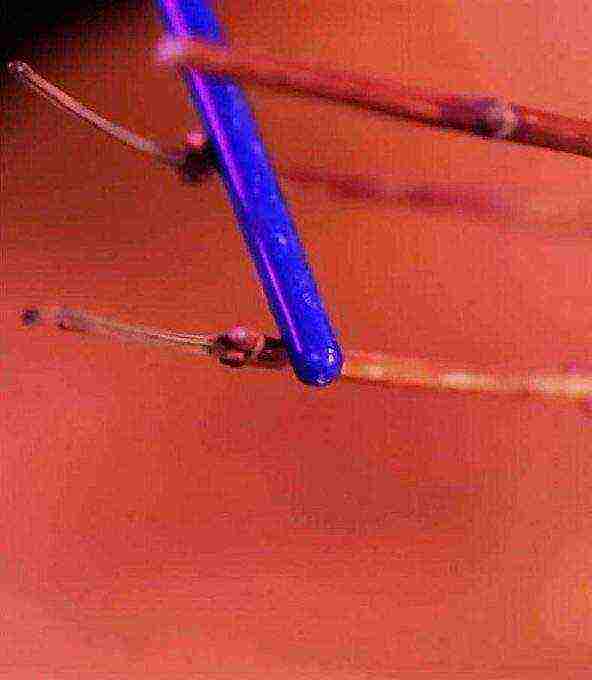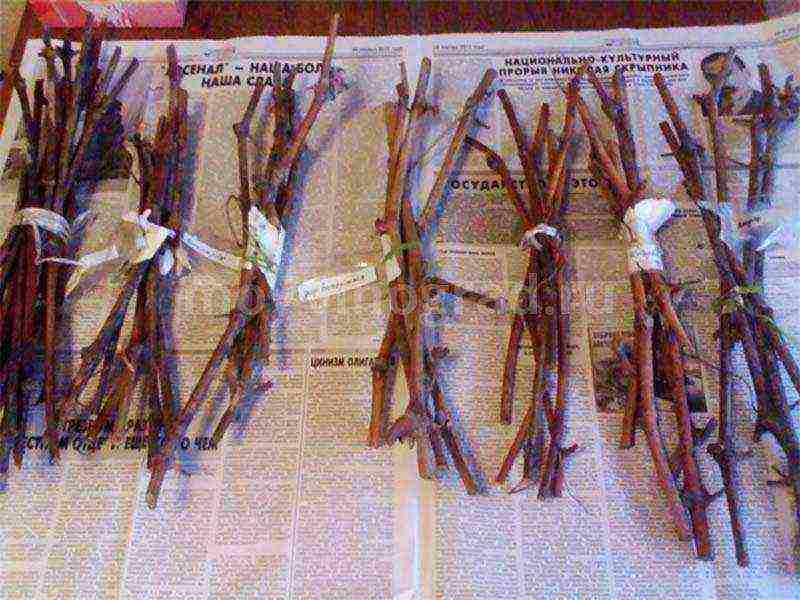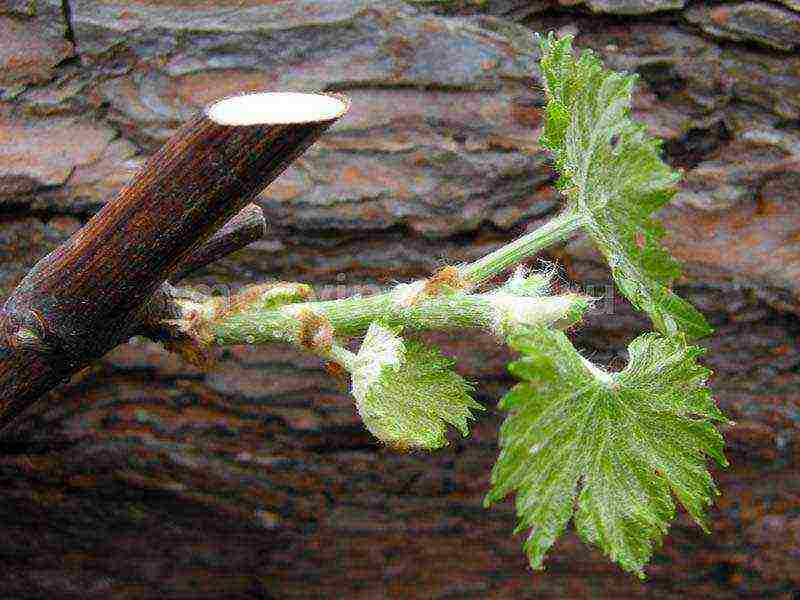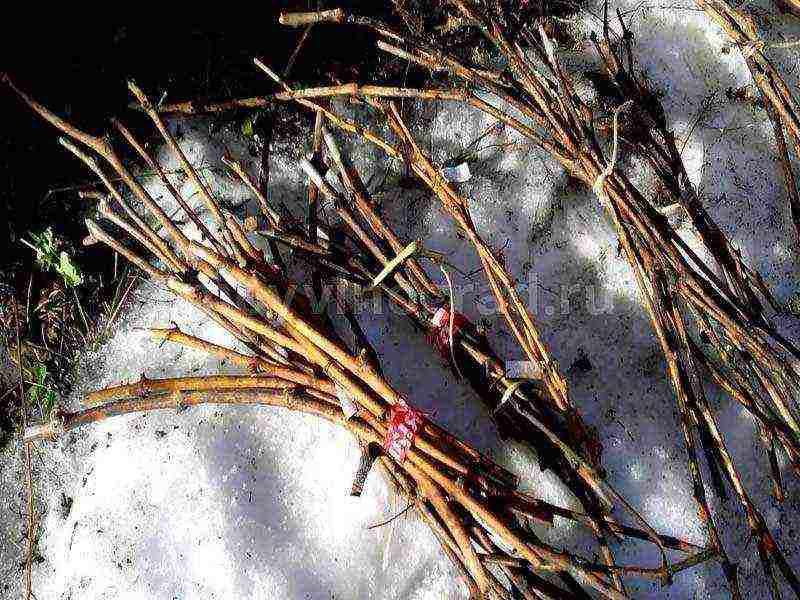Content
- 1 How to store seedlings in the spring before planting at home
- 2 Inspection and preparation
- 3 How to preserve seedlings before planting
- 4 Storage conditions
- 5 Harvesting grape cuttings in autumn
- 6 How to properly prepare shanks for storage?
- 7 How to choose a good planting material?
- 8 Storage conditions for grape seedlings in winter
- 9 Storage technologies before planting in the ground
- 10 How to save purchased seedlings before planting
- 11 Harvesting grape cuttings in spring
- 12 Germination of cuttings and planting
- 13 The main mistakes when choosing and storing shanks
- 14 Popular questions and answers
- 15 Useful video
- 16 Outcome
Every seasoned gardener knows that most seedlings of roses, grapes or fruit trees are best bought in early fall and planted right away. But often acquired young plants cannot be planted on time due to total employment or early frosts. In addition, in modern garden centers and supermarkets, fresh seedlings appear on sale at the beginning of the year - January-February. And in these cases, the gardener needs to decide how to preserve the seedlings until spring, when they can be planted in open ground.

In principle, the danger of planting seedlings in winter is sometimes greatly exaggerated, because the root system can develop at an earth temperature of +3 degrees, which in the middle lane lasts somewhere until mid-November. In addition, each plant can more easily tolerate digging, dividing and transplanting during the dormant period, that is, in autumn and winter, as it is easier for a person to endure surgical interventions under anesthesia. And at low temperatures, plants acquire the necessary immunity. But sometimes it is too late to plant, and you need to save them until the spring heat arrives.
Preservation methods
Experienced gardeners know perfectly well how to preserve seedlings until spring, offering the following methods:
Storage in prikop
This is a very common method that is used in the fall, before the onset of frost, in order to preserve young plants until spring. To do this, a trench is dug in a sunny, dry and draft-free place, its length depends on the number of plants and is calculated at the rate of 20 centimeters for each crop plus the same amount of free space. The width is about the same as a regular wooden box, and the depth of the trench should be about 55-60 centimeters.
In no case should a ditch be dug in an area with a close occurrence of groundwater, because moisture contributes to rotting and freezing of the roots. You need to dig a trench in the west-east direction, while the southern slope is made at an inclination of 45 degrees, and the northern one - vertically. It is also recommended for heavy soils to lighten them in advance by mixing with sand and peat, because in spring it will be easier to remove the roots from light soil without damaging them. At the bottom of the ditch for thermal insulation, it is advised to lay moss, needles or sawdust in a layer of 10-15 centimeters.
Before digging in, the seedlings must be prepared for winter. To do this, remove excess leaves from them in advance, and then lower the roots into water with normal moistening of the root system for 5 hours, and when drying out - for a day - two. The water must be clean, free of nitrates and impurities. After soaking, the roots are pruned, injured and dead areas are removed.
Further, seedlings are placed in the grooves, directing the roots to the north, and the tops to the south, this will provide maximum illumination of young plants. After that, they are sprinkled with earth with a layer of 20 centimeters, the trench is generously watered and then crushed with soil a little more. Before frosts, the trench is completely covered with earth, covering the plants in the form of a mound. Young plants are removed only after the soil has completely thawed, which occurs somewhere in April.
Cold storage
If it's already frosty outside, then it's difficult to make a hole. In this case, it can be stored in containers or plastic bags. The main thing in this matter is to prevent the awakening of seedlings and budding, as well as drying out of the root system.
For such storage, you need to prepare boxes or ordinary plastic bags and a substrate for seedlings. It should be steamed, mixed and cooled in advance. A seedling with a bare root system is placed in a bag, into which the substrate is gradually poured, gently straightening the roots and filling all the space between them. It is important that no air spaces and bubbles remain inside the root system. Next, several holes are made in the bag for ventilation, the substrate is moistened, and the bag is tied to maintain the desired humidity.
When storing in a cellar, you need to tie a bag over the root collar, but if refrigeration is supposed to be stored, then you need to wrap the plant up to the branches of the shoots. Next, the packed seedlings are placed in the cold, as it was said, you can use the basement, cellar, glazed balcony or lower shelves of the refrigerator, if only the temperature is stable within 0 - +5 degrees. It is convenient to store small plants in the refrigerator, but seedlings of fruit trees and bushes will have to be determined in other places.
It is not worth unwinding the film regularly; it is enough to check the kidneys only once every two weeks. Under such conditions, young plants will remain immersed in a state of dormancy and will feel great in winter.
Snowing
Despite the fact that snow is an indispensable attribute of winter, and that, in turn, is detrimental to seedlings, the snow cover is an excellent protection from the cold for young plants. Therefore, in cases where in winter the snow lies with a layer of at least 15 centimeters, packed in polyethylene and you can dig in it, and on top, for long-term preservation of the snow cover, you need to sprinkle sawdust with a layer of 10 centimeters. This will protect the snow from melting, and the seedlings from temperature extremes.
Preserving rose seedlings
Most of the true connoisseurs of roses prefer to buy seedlings in winter or early spring, because by the beginning of the planting season, all the standing varieties have already been disassembled. But you cannot immediately plant whimsical young rose bushes in open ground until the arrival of stable heat, and here you need to try to keep the plants in good condition. To do this, use:
- Prikop in the snow, for this, on an area with a constant snow cover, holes are dug and hollowed out to the ground, rose seedlings are placed in them, after which the plants are sprinkled with purchased substrate and covered with spunbond. In this position, rose bushes will tolerate frost well and wake up along with other plants planted in open ground.
- Cold storage, in which the shoots are wrapped in a couple of layers of newspaper and polyethylene and placed on the bottom shelf of the refrigerator. It is important to check the moisture content of the soil near the roots of rose seedlings, too wet can provoke rotting of the roots, and dry - their drying out and death of the plant.
- Keeping rose seedlings in containers indoors. This extreme option is very undesirable for proper further growth, but the only possible one if the shoot had time to wake up and dissolve the leaves. To do this, young rose bushes must be planted in a container of sufficient volume so that the roots can develop normally.It is also necessary at first to protect the rose bushes from light so that they do not stretch upwards before their root system gets stronger. After planting the plants in loose soil, they need to be packed entirely in polyethylene and placed in a room with a temperature of 10-15 degrees in order to slow down growth, it is also important to carefully monitor the moistening of the earthy coma. In such a method of preserving planting material, a lot of attention and care is required from the gardener.
Conservation of grape seedlings
Since this plant grows in the wild in warmer climates, it is very important to properly protect it from frost. Need winter care and grapes.
If a seedling is purchased and immediately transported home without drying out the roots, then it can be immediately immersed in containers with moistened sand (humidity should be low, about 10-20%). If grape seedlings were sent by mail or transported for a long time, then they need to be soaked in water for a day, some experts recommend using melted snow water for this purpose.
Before burying the roots of grapes in the sand, it is advisable to sprinkle with a solution of potassium permanganate in order to protect the plant from diseases. Next, the roots of the grapes are buried in containers, boxes or plastic bags filled with moistened sand, which will allow the roots to breathe. When digging in, the root collar must remain on the surface. Further, containers with young shoots of grapes are transferred to a cool room. The correct temperature is very important here, because at zero the vine dries up, and at +5 and above, buds can bloom, since the dormant period for the culture ends at the end of December.
The humidity in the room is also important, it should be high enough, but not one hundred percent, therefore basements with the danger of flooding and the close occurrence of groundwater are not suitable - the vine can rot under such conditions. It is recommended to regularly maintain light moisture in the sand; for this, some gardeners recommend rolling a medium-sized snowball out of snow in the middle of winter and putting it on a container, it will melt gradually, evenly giving moisture to the sand and ensuring that the optimum temperature is maintained.
If it is not possible to store grapes in a cellar or basement, then you can simply bury them in a pre-prepared hole more than 1 meter deep into the open ground, sprinkling them with peat, sawdust or compost. So the plants will overwinter well, and in the spring a pit will be ready for planting one vine.
Conservation of fruit tree seedlings
Such seedlings winter best in cellars, for this you need to remove the leaves from the plants and place the roots in containers with moist soil. If, due to transportation or store storage, the root system is dry, then it must be soaked in water for several hours before planting. During the cold period, you need to regularly monitor the moisture content of the substrate, avoiding drying out.
Often the highest quality and most interesting varieties of plants can be purchased in late autumn or winter, when it is too late to plant them in open ground, and in this case, you need to know how to preserve them before planting so that they take root and grow well in spring.
Was this helpful?
Rate the article:
How to store seedlings in the spring before planting at home
In February-April, the active sale of seedlings begins. Fairs and nurseries are full of boxes with future trees, shrubs, flowers. Eyes run up, and there is a desire to buy a lot at once. You should not refuse, there are several ways how to preserve seedlings before planting at home.

Inspection and preparation
Before storing purchased seedlings, you need to immediately mark (hang a tag with the name of the variety), inspect the buds and roots.
The introduced specimens in February-March most likely still have dormant buds.

There may also be those that have already grown, but still small, no more than 2 cm. They are also suitable for "sealing".

If the buds are already actively growing, then before planting in a permanent place, the seedling is planted in a pot as a houseplant.
Cut off soaked and broken off roots, long, dry or diseased shoots with a garden pruner. Shorten long roots. Treat the cuts with brilliant green or sprinkle with crushed coal.
Shoots damaged by the fungus cannot be left for storage, the disease will spread throughout the seedling and by the time of planting there will be nothing to plant.
If young trees were sent by mail, then the root system could dry out. Before storing, wrap the spines in a damp cotton cloth and hold for a while.
In grafted specimens, especially rose seedlings, the site of the graft is checked. Often there is no protective paraffin plug and to protect the sensitive area, it is wrapped in polyethylene.
How to preserve seedlings before planting
It is difficult to keep the purchased seedlings at home, because in addition to the coolness, you still need to find a place. We offer several options:
- Prepare a clean, thin plastic wrap, punch holes in it for ventilation. Wrap the seedlings, then wrap them in newspaper to protect them from light, and secure with elastic bands or ribbons. Place in dry plastic containers and store in a cool, dark place.
- The cuttings are usually small and can be stored in the refrigerator on the bottom shelf.
- Large seedlings of trees and shrubs are placed in boxes with wet sand, while the roots are not wrapped.
- To prevent the root system from drying out, place it in a plastic bag, make several holes in it so that the roots do not start to rot. Wrap the top with newspaper and secure with ribbons or an elastic band. Place in a plastic container and place in a dark, cool place; at home, a balcony would be the best option.
A hood made of newspaper or covering material, put on the seedling, will protect from sunlight, thereby prolonging the dormant period.
- Plant as a houseplant. Note that each pot has drainage holes that we don't need. So that the water does not wash out, the bottom of the pot is covered with a cloth and only then the earth is poured.
Soak cuttings or seedlings in potassium humate before planting. How to prepare the solution is indicated on the package. After planting, transfer the pot to a room where the temperature ranges from 5-7 ° C. When the buds wake up and grow, transfer the pot to a bright, cool place.
You can save grape shoots before planting in other ways, more details can be found in the topic "How to save grape cuttings in winter."

Storage conditions
It is important to monitor temperature and humidity levels prior to planting. A hygrometer will be a good helper here. The ambient temperature should be within 0… + 2 ° С. It is with her that the plants fall into a state of dormancy and calmly survive the waiting time.
If the apartment is on the ground floor and there is a cellar, then it is better to transfer the seedlings for storage until they are planted in the cellar.
During rest, do not open the planting material, and do not touch it again, it is quite enough once a month to very carefully check the condition of the kidneys.
If the seedlings were bought in the fall, but you need to save it until spring, then for the winter they are placed in a pit. To protect against field rodents, spread juniper or spruce branches on top.
Other entries about grapes
Hello! I ask you to answer, is it possible to mulch the vineyard with a black film, having previously placed 10-15 cm of fresh or withered grass under it? The soil is clayey black earth, if it rains, you can't fit into the garden, and if it's hot, the soil cracks ...
Advise grape varieties for beginners ... The dacha is located in the Leningrad region, Luga district. I would like 3-4 varieties of different ripening times.
Dear experts, wine grapes are scattered all over the garden by the previous owners. There is no one to look after him, and he takes a place, I want to lime him, but so that the previous owners do not offend (our dacha is next to their relatives). Maybe have…
Dear gardeners, what about grapes and how can you help him?
Since today, the average temperature has exceeded zero and became positive. Probably need to go to open the grapes?
A question from Vladimir - a subscriber of our official group in VK: Friends, my grapes are blooming, it's already late, is it not harmful for the bush? Rostov region.
See all materials
about grapes :
See all
Establishing a luxurious vineyard on your site is quick and easy. Even an inexperienced gardener can handle this. There are several main ways to plant grapes:
- seedlings;
- cuttings;
- layering.
Cutting is a vegetative propagation method, as a result of which a young plant appears from a part of an old shoot - a cutting. For the breeding process, cuttings of a one-year-old fruiting vine, called shanks, are most often used. They can be green or lignified.
The process is very laborious and not the easiest one. However, the success of the operation depends on the correct observance of all instructions.
Harvesting grape cuttings in autumn
Lignified cuttings are prepared in autumn. For the procedure, choose the time after the leaves fall, but before the onset of the first frost. During this period, the buds of the shoots are finally formed and contain a large amount of nutrients. They can easily survive the winter and will immediately grow. This is one of the most reliable and 100% rooting methods.
How to properly prepare shanks for storage?
To prepare material for planting, choose a healthy vine, up to 1 cm in diameter, and cut off its upper part. Leaves, antennae, unripe tops are removed from trimmed shoots, keeping 4 eyes each.
The upper cut is made a few centimeters above the upper kidney. The bottom is cut vertically in three places, forming a cut about 3 cm in length. This procedure will ensure the normal metabolism of the cuttings after planting in the open field.
The procedure is carried out with a sharp knife at an angle. It is important to prepare garden tools before starting the operation. To do this, it is cleaned and processed to prevent the spread of disease.
Attention! Trimming the shanks is extremely important. If you cut the cutting incorrectly, it will dry out or die.
If you are preparing cuttings of different varieties, they must be marked and collected in bunches. This is done so that the plants do not infect each other at rest. Then they are dipped into water for a day. Then it is treated with a 5% solution of copper sulfate and dried well.

After that, they are placed in plastic wrap and sent to storage. The cuttings must survive the winter, get stronger and in early spring they can be planted in open ground at a permanent place of growth.
Important! Treatment of cuttings with water and vitriol contributes not only to disinfection, but also to the accumulation of a supply of nutrients that will help the plant survive hibernation.
How to choose a good planting material?
The success of the operation directly depends on the quality of the planting material. Pick healthy, sturdy cuttings before you start pruning.
You need to start with a preliminary inspection of the vine. The color of the shoots should be uniform brown-green. There should be no damaged spots, cuts, spots or rot.
The diameter of a healthy stem should range from 0.6 to 1.0 cm. The length can vary from 12 to 60 cm. A shoot that is too short will not be able to survive the winter due to lack of strength and nutrients. Cuttings that are too long do not store well.
Preservation of 2 to 4 eyes will allow the plant to quickly take root and immediately enter the phase of development and growth when transplanted into open ground.

Storage conditions for grape seedlings in winter
Keeping the shanks until spring is also a must. Optimal storage conditions are considered to be between 0 and +5 degrees Celsius. It is important to ensure that no mold builds up. The storage area should be dark to prevent direct sunlight.
Storage technologies before planting in the ground
During storage, the plant loses half of its nutrients and quickly weakens, becoming unsuitable for planting. The main task of the procedure is to reduce losses. You can store cuttings in the basement, refrigerator, or buried in the ground. Low temperature and darkness slows down life processes and leads to a decrease in nutrient consumption.
How to store in a basement or cellar?
When storing shafts in the basement, it is important to keep the temperature constant. It should not drop below 0 degrees. Otherwise, the air will become too cold and the vine will freeze. It is important not to allow the temperature to rise more than +4 degrees. In this case, the buds will begin to swell and bloom ahead of time. It is possible to regulate the temperature and humidity conditions of the room by providing ventilation and airing.
It is important to ventilate the cuttings themselves. To do this, several holes are made in plastic wrap, which is wrapped around the shoots. At least once a month, the film is unrolled and the cuttings are examined. In case of mold formation, it is wiped with a cloth dipped in a solution of copper sulfate. When the vine dries up, it is moistened with water.
Another popular way to retain moisture and reduce nutrient loss is to use wet sand or pine sawdust. To do this, they are added in small quantities to a plastic bag in which the cuttings are stored.

How to keep in the refrigerator until planting?
This method is good only for storing a small number of cuttings, the length of which does not exceed half a meter. In this case, the shelves with cuttings are stacked at a distance of at least 10 cm from each other.
Cuttings prepared and treated with water and vitriol are wrapped in a thin cloth and placed in plastic bags. Once a month, the packages need to be opened, the vine should be treated with copper sulfate and moistened.
Interesting! To make sure that the temperature in the packages is correct, experienced gardeners put a thermometer in it for a couple of hours.
In the trench
One of the simplest and least labor-intensive ways of storing cuttings is a prikop. To do this, they dig a shallow hole, place shoots in it and cover it with earth. It is necessary to choose a secluded place where water does not accumulate, otherwise the cuttings may rot. Dry soil provides excellent protection against mold, disease and nutrients.

How to save purchased seedlings before planting
Most often, seedlings for sale come in late autumn or winter. However, it is recommended to plant them in open ground in the spring. You can find out how to save them before planting in the video.
Harvesting grape cuttings in spring
For propagation of grapes, green cuttings can be used. They are prepared in spring, 2 weeks before the plant enters the flowering phase.
First of all, choose healthy shoots. On cut cuttings, 2 eyes are kept, and the leaf blades are cut in half.
Attention! The procedure is recommended to be carried out in the early morning, when plant tissues are most saturated with moisture.
Then the shanks are dipped in water for a day and covered with a cloth. Rooting is started immediately. For this, containers are prepared, where the lower drainage layer of pebbles is laid, soil for grapes, fertilizers and sand are poured. Cuttings are planted to a depth of 4 cm, at a distance of 10 cm from each other.
The containers are covered with foil to maintain high temperature and humidity. During the first month after planting, it is necessary to maintain soil moisture at 100%, air - 85% and temperature - up to 30 degrees Celsius.
In the following months, the number of waterings is gradually reduced to 2 times a day. After the cuttings germinate, the film must be removed, starting to accustom the plant to the natural conditions of the environment.
By the end of summer, it is necessary to treat the shanks with fungicides to prevent the development of diseases. It is recommended to leave the cuttings in this form for a year for full development and start transplanting in the spring.
Germination of cuttings and planting
Planting cuttings in open ground is carried out in early spring. Before proceeding with the procedure, the shanks must be prepared and rooted.
To do this, a couple of weeks before planting, they are taken out of storage and transplanted into plastic cups. This will help the plant adapt more quickly and get out of the dormant state.
First, the cuttings are soaked for up to 48 hours in warm water. Then several holes are made at the bottom of the cups. Then the earth and humus. Sprinkle with fine sand on top. A cutting is placed in a cent to a depth of about 4 cm, and then watered.
You can learn more about the process from the video.
The main mistakes when choosing and storing shanks
- It is important to choose healthy and sturdy stems for pruning. They should be about 8mm thick. It is recommended to cut off the middle part of the vine, as this is where healthy buds and a large amount of nutrients are concentrated.
- During the period of preservation of the shanks before planting, they lose a large amount of moisture. In order to replenish it, they must be soaked in water for two days.
- To protect the cuttings from diseases, it is imperative to treat them with a solution of copper sulfate. To do this, add a spoonful of the substance to 1 glass of water.
- If the cuttings are kept in the ground, they should be protected from decay. For this, the outside temperature should be about 0 degrees. You can mix the soil with sand.
Popular questions and answers
Below we will look at popular questions and answer them.
Why did the buds begin to grow, but there are no roots?
A phenomenon is often observed when the buds begin to develop actively, and the root system is delayed. To do this, it is necessary to process the roots with growth stimulants. Most often this is due to the characteristics of the grape varieties. Some of them are more difficult to take root.
Why did the roots start moving, but there are no buds?
This problem is associated with non-observance of the optimal temperature and humidity storage conditions. Due to the dry air, the kidneys dry out. Most often, the phenomenon is observed when storing shanks in an apartment. To solve the problem, it is necessary to cover the cutting with soil a couple of centimeters above the upper bud and keep the soil moist.
Useful video
Learn more about storing shanks from the video below:
Outcome
Everyone can grow grapes on their own plot. Cutting is one of the most economical and successful propagation methods. Feel free to experiment with the grape varieties you like. If you strictly follow the basic recommendations, you will be provided with a rich harvest of useful berries.


